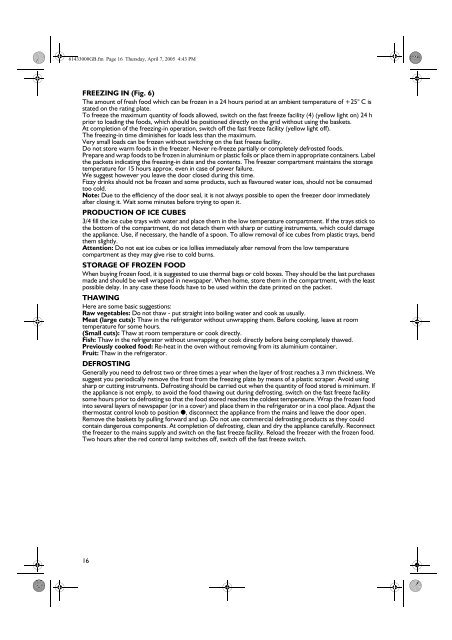KitchenAid ZFA101L - Freezer - ZFA101L - Freezer EN (850704101000) Istruzioni per l'Uso
KitchenAid ZFA101L - Freezer - ZFA101L - Freezer EN (850704101000) Istruzioni per l'Uso
KitchenAid ZFA101L - Freezer - ZFA101L - Freezer EN (850704101000) Istruzioni per l'Uso
Create successful ePaper yourself
Turn your PDF publications into a flip-book with our unique Google optimized e-Paper software.
61433000GB.fm Page 16 Thursday, April 7, 2005 4:43 PM<br />
FREEZING IN (Fig. 6)<br />
The amount of fresh food which can be frozen in a 24 hours <strong>per</strong>iod at an ambient tem<strong>per</strong>ature of +25° C is<br />
stated on the rating plate.<br />
To freeze the maximum quantity of foods allowed, switch on the fast freeze facility (4) (yellow light on) 24 h<br />
prior to loading the foods, which should be positioned directly on the grid without using the baskets.<br />
At completion of the freezing-in o<strong>per</strong>ation, switch off the fast freeze facility (yellow light off).<br />
The freezing-in time diminishes for loads less than the maximum.<br />
Very small loads can be frozen without switching on the fast freeze facility.<br />
Do not store warm foods in the freezer. Never re-freeze partially or completely defrosted foods.<br />
Prepare and wrap foods to be frozen in aluminium or plastic foils or place them in appropriate containers. Label<br />
the packets indicating the freezing-in date and the contents. The freezer compartment maintains the storage<br />
tem<strong>per</strong>ature for 15 hours approx. even in case of power failure.<br />
We suggest however you leave the door closed during this time.<br />
Fizzy drinks should not be frozen and some products, such as flavoured water ices, should not be consumed<br />
too cold.<br />
Note: Due to the efficiency of the door seal, it is not always possible to open the freezer door immediately<br />
after closing it. Wait some minutes before trying to open it.<br />
PRODUCTION OF ICE CUBES<br />
3/4 fill the ice cube trays with water and place them in the low tem<strong>per</strong>ature compartment. If the trays stick to<br />
the bottom of the compartment, do not detach them with sharp or cutting instruments, which could damage<br />
the appliance. Use, if necessary, the handle of a spoon. To allow removal of ice cubes from plastic trays, bend<br />
them slightly.<br />
Attention: Do not eat ice cubes or ice lollies immediately after removal from the low tem<strong>per</strong>ature<br />
compartment as they may give rise to cold burns.<br />
STORAGE OF FROZ<strong>EN</strong> FOOD<br />
When buying frozen food, it is suggested to use thermal bags or cold boxes. They should be the last purchases<br />
made and should be well wrapped in newspa<strong>per</strong>. When home, store them in the compartment, with the least<br />
possible delay. In any case these foods have to be used within the date printed on the packet.<br />
THAWING<br />
Here are some basic suggestions:<br />
Raw vegetables: Do not thaw - put straight into boiling water and cook as usually.<br />
Meat (large cuts): Thaw in the refrigerator without unwrapping them. Before cooking, leave at room<br />
tem<strong>per</strong>ature for some hours.<br />
(Small cuts): Thaw at room tem<strong>per</strong>ature or cook directly.<br />
Fish: Thaw in the refrigerator without unwrapping or cook directly before being completely thawed.<br />
Previously cooked food: Re-heat in the oven without removing from its aluminium container.<br />
Fruit: Thaw in the refrigerator.<br />
DEFROSTING<br />
Generally you need to defrost two or three times a year when the layer of frost reaches a 3 mm thickness. We<br />
suggest you <strong>per</strong>iodically remove the frost from the freezing plate by means of a plastic scra<strong>per</strong>. Avoid using<br />
sharp or cutting instruments. Defrosting should be carried out when the quantity of food stored is minimum. If<br />
the appliance is not emply, to avoid the food thawing out during defrosting, switch on the fast freeze facility<br />
some hours prior to defrosting so that the food stored reaches the coldest tem<strong>per</strong>ature. Wrap the frozen food<br />
into several layers of newspa<strong>per</strong> (or in a cover) and place them in the refrigerator or in a cool place. Adjust the<br />
thermostat control knob to position ●, disconnect the appliance from the mains and leave the door open.<br />
Remove the baskets by pulling forward and up. Do not use commercial defrosting products as they could<br />
contain dangerous components. At completion of defrosting, clean and dry the appliance carefully. Reconnect<br />
the freezer to the mains supply and switch on the fast freeze facility. Reload the freezer with the frozen food.<br />
Two hours after the red control lamp switches off, switch off the fast freeze switch.<br />
16
















